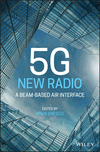PHY Layer
Summary
This chapter begins by focusing on two main design elements: the 5G waveform and the antenna architectures. It describes the basic system design components such as frame structure and resource allocation, synchronization signals, and broadcast channels, the physical random access channel (PRACH). The chapter discusses various aspects of how the antenna arrays that are being used in 5G NR systems are implemented and configured for creating a ‘beam-based air interface.’ It describes some of the basics of beam forming for receiving and transmitting and describes the idea of antenna virtualization. The chapter explains how all these ingredients are put together to form a beam-based air interface. A short description on power control is also provided. The ends with a description of the downlink and uplink transmission framework.



